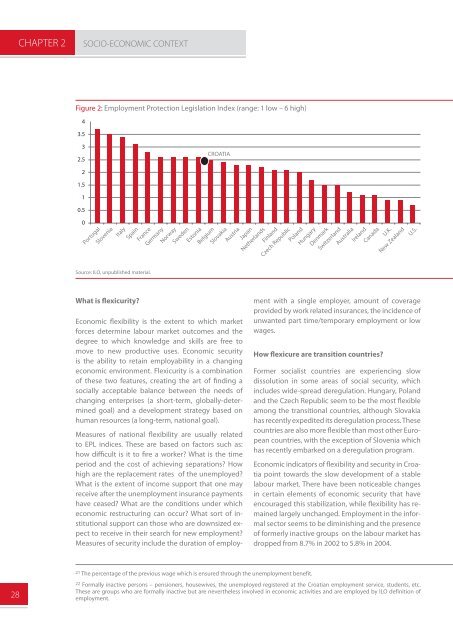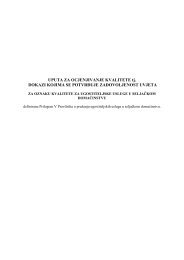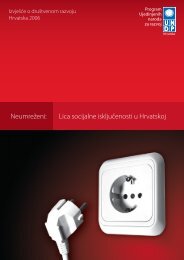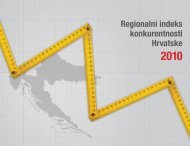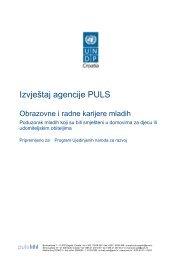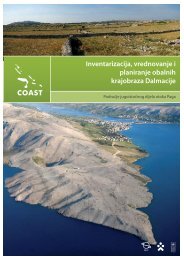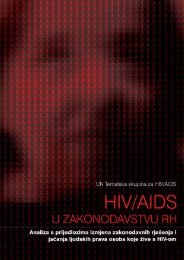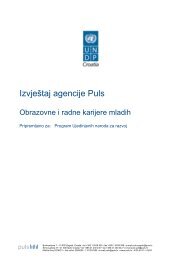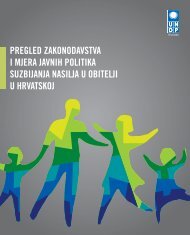WEB engleska verzija end.indd - UNDP Croatia
WEB engleska verzija end.indd - UNDP Croatia
WEB engleska verzija end.indd - UNDP Croatia
- No tags were found...
Create successful ePaper yourself
Turn your PDF publications into a flip-book with our unique Google optimized e-Paper software.
CHAPTER 2SOCIO-ECONOMIC CONTEXTFigure 2: Employment Protection Legislation Index (range: 1 low – 6 high)43.532.5CROATIA21.510.50PortugalSloveniaSource: ILO, unpublished material.What is flexicurity?ItalySpainFranceGermanyNorwaySwedenEconomic flexibility is the extent to which marketforces determine labour market outcomes and thedegree to which knowledge and skills are free tomove to new productive uses. Economic securityis the ability to retain employability in a changingeconomic environment. Flexicurity is a combinationof these two features, creating the art of finding asocially acceptable balance between the needs ofchanging enterprises (a short-term, globally-determinedgoal) and a development strategy based onhuman resources (a long-term, national goal).EstoniaBelgiumSlovakiaAustriaJapanNetherlandsFinlandCzech RepublicPolandHungaryDenmarkSwitzerlandAustraliaMeasures of national flexibility are usually relatedto EPL indices. These are based on factors such as:how difficult is it to fire a worker? What is the timeperiod and the cost of achieving separations? Howhigh are the replacement rates of the unemployed?What is the extent of income support that one mayreceive after the unemployment insurance paymentshave ceased? What are the conditions under whicheconomic restructuring can occur? What sort of institutionalsupport can those who are downsized expectto receive in their search for new employment?Measures of security include the duration of employmentwith a single employer, amount of coverageprovided by work related insurances, the incidence ofunwanted part time/temporary employment or lowwages.How flexicure are transition countries?IrelandCanadaU.K.New ZealandU.S.Former socialist countries are experiencing slowdissolution in some areas of social security, whichincludes wide-spread deregulation. Hungary, Polandand the Czech Republic seem to be the most flexibleamong the transitional countries, although Slovakiahas recently expedited its deregulation process. Thesecountries are also more flexible than most other Europeancountries, with the exception of Slovenia whichhas recently embarked on a deregulation program.Economic indicators of flexibility and security in <strong>Croatia</strong>point towards the slow development of a stablelabour market. There have been noticeable changesin certain elements of economic security that haveencouraged this stabilization, while flexibility has remainedlargely unchanged. Employment in the informalsector seems to be diminishing and the presenceof formerly inactive groups on the labour market hasdropped from 8.7% in 2002 to 5.8% in 2004.21 The percentage of the previous wage which is ensured through the unemployment benefit.2822 Formally inactive persons – pensioners, housewives, the unemployed registered at the <strong>Croatia</strong>n employment service, students, etc.These are groups who are formally inactive but are nevertheless involved in economic activities and are employed by ILO definition ofemployment.


